This Simulation Peered 1 Million Years Into the Future and It Held Up

When it comes to nuclear waste, the stakes are immense, and the timelines stretch across millennia. Now, a team at MIT has developed a powerful new model that could help predict what happens to buried nuclear waste hundreds of thousands of years into the future, and the early signs suggest it works.
The model simulates how radioactive materials will interact with their underground surroundings, including clay, concrete, brine, and other geologic features found in deep geological repositories. What’s striking is that the team’s simulation closely matched real-world data from a long-term underground radioactive waste experiment in Switzerland, conducted at the Mont Terri Rock Laboratory.
“This is a huge step,” says study co-author Charles Forsberg, principal research scientist at MIT’s Department of Nuclear Science and Engineering. “We’re talking about designing systems that must remain safe and stable for tens of thousands, even a million years.”
The success of the model suggests it could be used to validate the safety of nuclear waste repositories before they’re built, helping to secure public trust and accelerate clean energy transitions that depend on nuclear power.
Global efforts to solve the nuclear waste problem have long been haunted by concerns over long-term stability. Waste from nuclear power plants remains hazardous for millennia, and storing it safely requires predicting the behavior of underground materials over unimaginable timeframes.
MIT’s model incorporates chemical transport, heat flow, and geologic interactions, offering a detailed simulation of how waste packages degrade and interact with the environment. It could help countries like Finland, Sweden, and the US finalize permanent nuclear waste sites with greater confidence.
With climate change pushing the world toward low-carbon energy, nuclear power is back on the table. But until waste can be safely locked away, its future remains uncertain.
This new model suggests we may finally have a tool smart enough to think in geologic time, and safe enough to bet the future on.